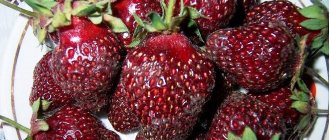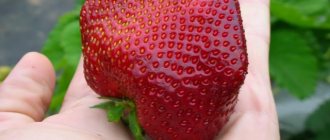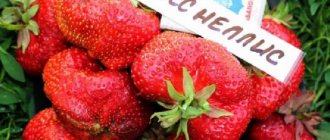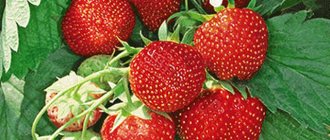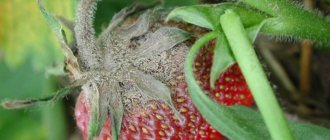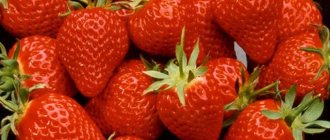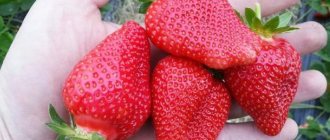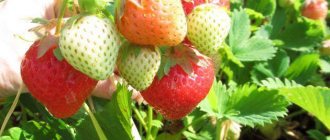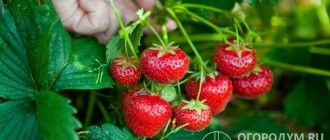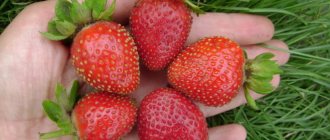Description and characteristics of the berry
This variety has the shape of a round, compact and spreading bush. Not too much foliage, rather long flower stalks. The absence of a mustache leaves the only method of reproduction by dividing one bush into several.
It bears fruit almost all summer, starting in mid-June. The bush bears hard berries. When ripe, they have a rich red color and a white-pink core. The average weight is from 15 to 25 grams, they are dense and hard enough to not be afraid of denting them. The berries taste sweet and sour and have a pleasant aroma.
The fruits ripen almost simultaneously, yielding about five and a half kilograms of berries per square meter. They are resistant to transportation and can be stored in refrigerators for up to 72 hours.
This variety is drought-resistant and not afraid of heat, however, excess sun and lack of moisture negatively affect the berries, making them small and less juicy.
Growing Eve
Since the country of origin of this variety of strawberry is Italy, it is very heat-loving and, to some extent, pampered. In greenhouses near Verona and Cesena (Italy), Eva demonstrated high yields. The autumn harvest was very satisfactory in the field in Verona, as well as with the soilless method of cultivation.
Despite this heat-loving nature, Eve can adapt to cooler latitudes. But for the first few years, you need to make an effort to create conditions for her under which she can survive. Here are the required temperature conditions:
- The minimum lethal temperature is -12 °C - Eva's strawberry will not survive stronger colds - it will freeze.
- During Eve's flowering, the critical temperature is -2 °C.
- For intensive growth of the vegetative system of strawberries: 10-13 °C at night, 18-22 °C during the day.
- When the thermometer drops below 6 °C, vegetative growth stops.
- Under conditions of 25-30 °C, strawberries will already need protection from heat.
For large agricultural areas, this strawberry is advantageous in that the entire crop of this variety ripens at the same time, if we consider it from the point of view of quality, firmness and sweetness. If the right moment for picking is chosen, then all the berries will be large in size, original, distinctive for the Eva variety, shape, will have a good degree of sweetness, aroma, elastic and dense pulp, pleasant, not too intense, color.
Reproduction
Take bushes aged from 2 to 4 years. Suitable with a good root system. The “horns” are separated - shoots with a rosette of leaves, apical and lateral buds, and adventitious roots.
The “horns” are dug up in spring or early autumn and transplanted into a new bed. The shoots are regularly watered and shaded a little if it is hot outside.
When propagated by seeds, germination time is 20–30 days.
SWEET MARY XXL
The new strawberry variety Sweet Mary XXL has a unique honey taste and refined strawberry aroma.
The characteristics of this variety attract gardeners. Strawberry Sweet has a pleasant sugary taste, which influenced the name of the berry - Sweet Mary. The unusually large berries reach a weight of 110 g.
This variety is characterized by high productivity. Strawberry Sweet bears fruit from May until frost. After the first harvest, the plant prepares for the next stage of ripening: buds are laid, new fruits are set. Ripening can occur even on unrooted and young rosettes of Sweet Mary XXL strawberries.
The plant has a strong stem with a powerful root system, which allows it to grow a bush up to 0.5 m high. This variety of strawberry perfectly withstands the onslaught of pests and diseases. It also tolerates frosts down to -20 C.
Landing
- It is necessary to plant seedlings in fresh beds.
- The best time is the second half of summer. Mainly from July to September. This will ensure sufficient survival rate.
- For faster ripening, it is recommended to remove flowers from young plants.
- The area for planting seedlings should be fertile, spacious and sufficiently lit.
- The distance between bushes in a row should be from 35 to 50 cm, and between two adjacent rows - from 60 to 80 cm.
- The time interval between preparing the bed and planting seedlings should be at least a month.
- The soil must be cleared of weeds, fertilized with humus or compost (5 kg per square meter), as well as mineral fertilizers (50 - 70 gsq m of superphosphate, 20 -25 gsq m of ammonium nitrate, 20 -30 g of potassium salt per "square" ).
IMPORTANT! In order for the bush to bear fruit better, it is advisable to replant it every 4 to 5 years.
Cultivation of the variety
Reproduction method
Due to the lack of whiskers, Evi 2 seedlings are obtained by dividing the bushes. A strong, mature bush is dug up and vertically divided into parts so that each complete set contains rosettes of leaves and a full-fledged root. The resulting parts are planted in new places or instead of old plants more than 5 years old.
Planting strawberry seedlings
Disembarkation
Planting is possible in the spring after frosts or at the end of the warm season. Before planting, the soil is fertilized: 10 parts humus, 2 parts organic matter, 0.5 kg of ash. You should choose a sunny place. The beneficial effect of fertile soil will increase if legumes or spices such as dill, garlic, and parsley previously grew on it.
Sprouts are planted in the ground in rows. Between rows – 70 cm; between bushes in a row - 30 cm. For strawberry seedlings, dig holes with a radius of up to 30 cm and fill them with water. Plant the plant until it is densely planted and lay mulch on top.
Care
In arid climates, water abundantly; in temperate climates, use medium water. Drip irrigation method is preferred. From the moment of planting, fertilization with organic matter and minerals must be repeated monthly.
The plant overwinters quietly at -22 degrees under snow. But for lower temperatures, mulching with sawdust, humus, pine needles or other natural insulating materials is required. With any method of covering, it is necessary to cover the strawberry bed with a thick layer of snow so that winter frost does not reach it.
Watering strawberries
Watering
The amount of water spent on irrigation depends on the soil on which the strawberries are planted. So, for loose soil it is 12 liters per square meter, and for clay soil - 14 liters per “square”.
In the morning, when it is still cool, it is better to use warm water for irrigation. Also, the amount of water depends on the prevailing weather - during rains it is better to stop watering altogether, but during persistent heat it is increased more often, watering 3 - 4 times a week.
Top dressing
During the planting period, the plant is fed with a mixture of mullein and ammonium sulfate, with a bucket of water containing 1 tablespoon of ammonium sulfate and two glasses of mullein. It is also possible to feed with a 10% solution of mullein and chicken manure diluted in a ratio of 1:12.
When the strawberries are already beginning to bear fruit, they are fed with a mixture of two tablespoons of nitrophoska and one teaspoon of potassium sulfate per bucket of water, or:
- Ash in a ratio of 100g per bucket of water.
- Two tablespoons of potassium nitrate diluted in a bucket of water.
In late autumn they change again:
- 10% mullein solution mixed with half a glass of ash.
- A mixture of two tablespoons of nitroammophoska, 30 grams of potassium sulfate and a glass of ash, which are dissolved in a bucket of water.
When to plant strawberries?
The most successful periods for planting strawberries are early autumn and early spring. Most often, strawberries are planted in September. This is done with pre-prepared seedlings. Strawberries are propagated vegetatively using tendrils on which future plants emerge, or by artificial propagation of a whole bush of seedlings, which is a small rosette with three to four leaves, a well-developed heart and root system.
It is recommended to disinfect purchased seedlings. To do this, the rosettes are washed together with the root system in the following solution: 3 tablespoons of table salt and one teaspoon of copper sulfate, diluted in 10 liters of water. Immerse strawberry rosettes in this solution for 10-15 minutes. If seedlings are planted in the spring, then the so-called “frigo” strawberries are considered the best for planting - these are seedlings that were dug up in the fall and kept at low temperatures all winter.
When planting any strawberry seedlings, you should neither bury nor raise the heart. Otherwise, in the first case it rots, and in the second case it dries out.
It is also very important when planting that the roots are straight and not tucked in. For early and mid-early varieties, planting in the first year is concentrated
The distance between rows is 60 cm, and between bushes in a row - 15 cm. With such concentrated planting in the first year, strawberries give a very high yield due to the concentration of planting.
As soon as the last harvest of berries is harvested, every second bush is removed, leaving a bush-to-bush distance of 30 cm in the garden bed.
For late varieties of strawberries, the planting scheme in the first year is as follows: between the rows there is a distance of 60 cm, in a row bush from bush - 20 cm. After the first summer harvest is harvested, every second bush is removed, and the plants remain at a distance of 40 cm from each other friend.
Strawberries planted in the fall begin to bear fruit in early July. The first two years, strawberries produce the best harvest. In the third year, the number of berries remains the same, but they themselves become smaller. So after receiving the third harvest, the strawberries must be removed from the plot. Although most often it is a pity for gardeners to do this, because the third harvest is usually still good. But this must be done, since after the third year the strawberries begin to degenerate.
Diseases and pests
One of the main threats is root blight. However, increased resistance to other diseases does not completely prevent their occurrence.
Because of this, this variety may develop diseases characteristic of other varieties:
- Powdery mildew.
- White or brown spots on leaves.
- Fusarium wilt.
- Gray rot.
IMPORTANT! To prevent outbreaks, it is necessary to replant the bushes in a different soil every two years. It is also worth observing planting density and treating with specific preparations when the first signs of damage appear.
Along with diseases, pests that threaten strawberries are:
- Nematodes are roundworms visible to the naked eye. Plants affected by them stop bearing fruit or bear deformed fruits. To protect the seedlings, you need to moisten them with warm water at a temperature of no more than 47 degrees for ten minutes, and then for fifteen minutes with cold water. The area affected by the nematode should not be used for at least seven years. Plants planted on new soil are sprinkled with lime along the edges.
- Strawberry mite - before flowering, strawberries are treated with karbofos or colloidal sulfur. After flowering - with the drug "Neoron".
- Weevils are beetles that overwinter in the upper layers of the soil, and when they wake up, they gnaw on the foliage. To combat them, 30 grams of 50% karbofos are dissolved in ten liters of water and the plants are treated with the resulting emulsion.
- Slugs and snails - dry superphosphate is placed around the plants, the bushes are treated with tobacco ash.
Preparing plants for winter
After the end of the season, it is necessary to prepare garden strawberries for wintering. This will preserve the plant and allow you to get a good harvest next year.
Feed the bushes with mineral and organic fertilizers. Fertilizing with ash and manure solution gives good results.
After cutting off the strawberry leaves and tendrils, burn them or bury them in a hole. This will help destroy the larvae of pests and pathogens, and the plant will smoothly go into a dormant state.
Quick recovery in the spring will be facilitated by mulching strawberries with hay, sawdust or pine needles. This will help retain the fallen snow and keep the roots at the temperature necessary for wintering.
